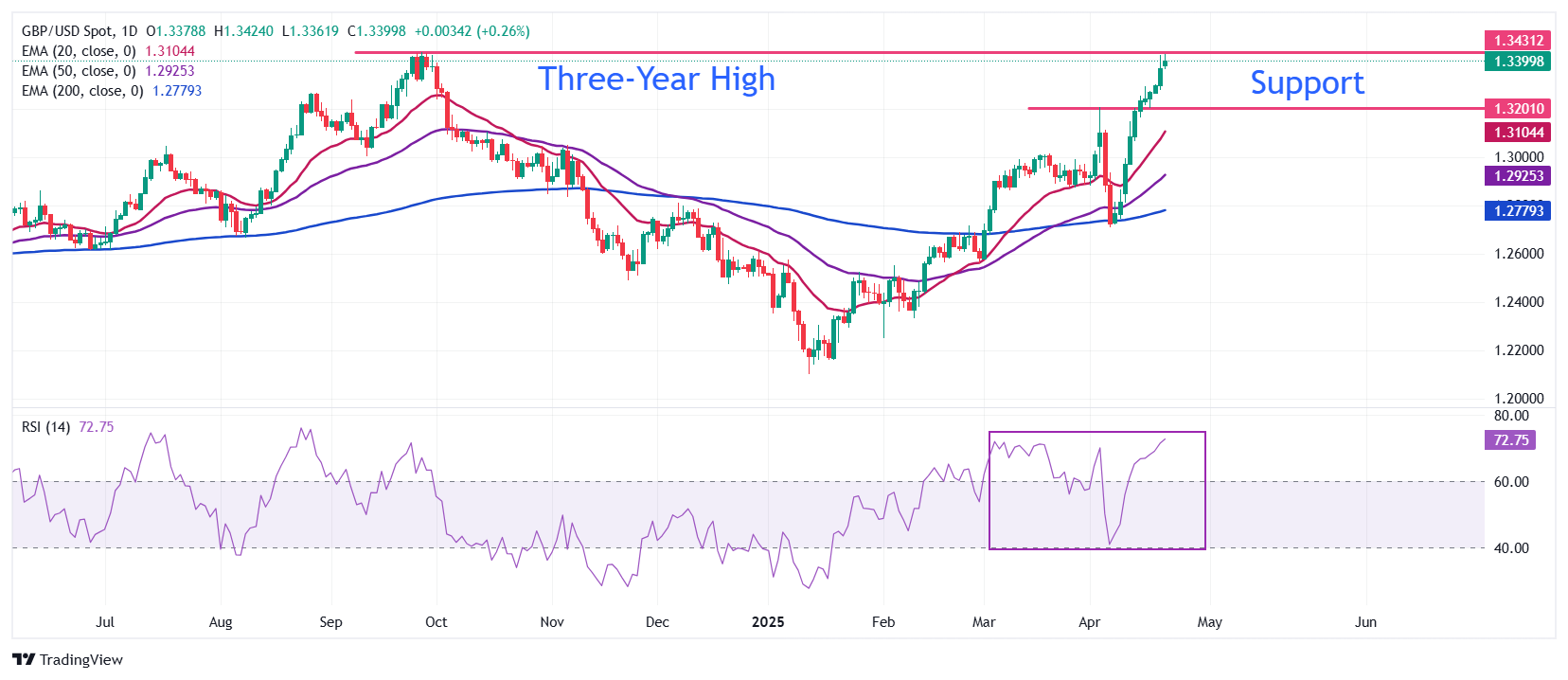- The Pound Sterling demonstrates firmness against the US Dollar near 1.3400 as Trump aims to sack Fed Powell for not cutting interest rates.
- The US Dollar is the major casualty of the feud between Trump and Powell.
- Investors expect the BoE to cut interest rates in May.
The Pound Sterling (GBP) shows strength near its three-year high around 1.3425 against the US Dollar (USD) in Tuesday’s European session. The GBP/USD pair is expected to see more upside as the USD continues to bleed due to United States (US) President Donald Trump’s attack on the Federal Reserve’s (Fed) independence for not reducing interest rates.
The US Dollar Index (DXY), which tracks the Greenback’s value against six major currencies, looks for temporary support after printing a fresh three-year low near 98.00.
On Monday, US President Trump slammed Fed Chair Jerome Powell again for supporting a “wait and see” approach on interest rates and warned that the economy could face shockwaves if the monetary policy is not eased. “There can be a SLOWING of the economy unless Mr. Too Late, a major loser, lowers interest rates, NOW,” Trump said through a post on TruthSocial.
Last week, Donald Trump threatened to sack Jerome Powell for maintaining a restrictive stance on the monetary policy outlook. Trump said, “I am not happy with him. If I want him out of there, he’ll be out real fast, believe me.” Financial market participants saw the event as an attack on the “autonomous” status of the Fed, whose decisions may not be influenced by political operations.
This led to investors reassessing the safe-haven status of the US Dollar, which had already been vulnerable due to ever-changing tariff policies by Donald Trump. His decision to impose worse-than-expected reciprocal tariffs and a sudden announcement of a 90-day pause on the same forced traders to doubt the credibility of Trump’s policy objectives, weighing on the US Dollar and US assets.
Daily digest market movers: Pound Sterling shows mixed performance ahead of flash PMI data
- The Pound Sterling demonstrates a mixed performance against its major peers on Tuesday as investors are cautious over how the Bank of England (BoE) will shape the monetary policy outlook under the threat of Trump’s international policies.
- Traders have become increasingly confident that the BoE could cut interest rates in the May policy meeting amid ongoing global economic tensions. There is a great chance that the UK will have a trade deal with Washington after Trump’s administration imposed 10% reciprocal tariffs and 25% levies on steel and foreign cars. However, the major threat to the UK is intense competition with other nations, assuming that Trump’s protectionist policies will force his trading partners to sell their products in other territories at lower prices.
- In the Financial Policy Committee (FPC) in April, the BoE warned that a major shift in “global trading arrangements” could harm “financial stability by depressing growth”.
- Additionally, cooler-than-expected UK Consumer Price Index (CPI) data for March also adds to expectations that the BoE could reduce borrowing rates in May. Inflation in the services sector, which is closely tracked by BoE officials, grew moderately by 4.7% against a 5% increase seen in February.
- This week, investors will focus on the release of the preliminary S&P Global/CIPS Purchasing Managers’ Index (PMI) data for April and the UK Retail Sales data for March, which will be published on Wednesday and Friday, respectively.
Technical Analysis: Pound Sterling rises to near 1.3400

The Pound Sterling revisits the three-year high slightly above 1.3400 against the US Dollar on Tuesday. The GBP/USD pair could witness more upside as all short-to-long Exponential Moving Averages (EMAs) are sloping higher.
The 14-day Relative Strength Index (RSI) reaches overbought levels above 70.00. This indicates a strong bullish momentum, but investors should be prepared for some correction ahead.
On the upside, the psychological level of 1.3500 will be a key hurdle for the pair. Looking down, the April 3 high around 1.3200 will act as a major support area.
Pound Sterling FAQs
The Pound Sterling (GBP) is the oldest currency in the world (886 AD) and the official currency of the United Kingdom. It is the fourth most traded unit for foreign exchange (FX) in the world, accounting for 12% of all transactions, averaging $630 billion a day, according to 2022 data.
Its key trading pairs are GBP/USD, also known as ‘Cable’, which accounts for 11% of FX, GBP/JPY, or the ‘Dragon’ as it is known by traders (3%), and EUR/GBP (2%). The Pound Sterling is issued by the Bank of England (BoE).
The single most important factor influencing the value of the Pound Sterling is monetary policy decided by the Bank of England. The BoE bases its decisions on whether it has achieved its primary goal of “price stability” – a steady inflation rate of around 2%. Its primary tool for achieving this is the adjustment of interest rates.
When inflation is too high, the BoE will try to rein it in by raising interest rates, making it more expensive for people and businesses to access credit. This is generally positive for GBP, as higher interest rates make the UK a more attractive place for global investors to park their money.
When inflation falls too low it is a sign economic growth is slowing. In this scenario, the BoE will consider lowering interest rates to cheapen credit so businesses will borrow more to invest in growth-generating projects.
Data releases gauge the health of the economy and can impact the value of the Pound Sterling. Indicators such as GDP, Manufacturing and Services PMIs, and employment can all influence the direction of the GBP.
A strong economy is good for Sterling. Not only does it attract more foreign investment but it may encourage the BoE to put up interest rates, which will directly strengthen GBP. Otherwise, if economic data is weak, the Pound Sterling is likely to fall.
Another significant data release for the Pound Sterling is the Trade Balance. This indicator measures the difference between what a country earns from its exports and what it spends on imports over a given period.
If a country produces highly sought-after exports, its currency will benefit purely from the extra demand created from foreign buyers seeking to purchase these goods. Therefore, a positive net Trade Balance strengthens a currency and vice versa for a negative balance.

